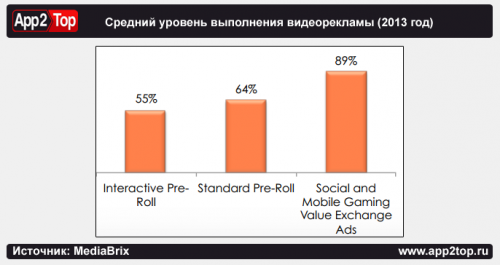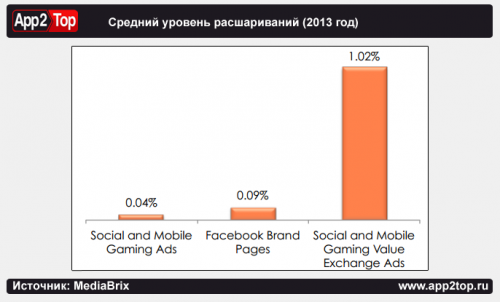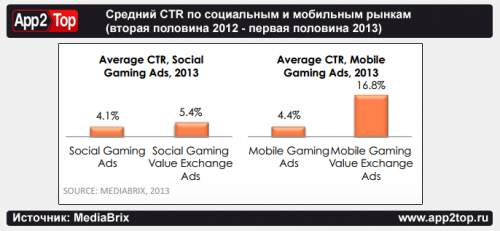The numbers decide. MediaBrix has published a study of the mobile and social gaming markets. It contains a comparison of CTR for social and mobile games, a detailed analysis of the American online advertising market, and much more.
The study can be found just below. To begin with, we, in turn, would like to clarify a couple of points. The term “targeted offer” is often found in the text. It is also value exchange ads.
It refers to advertising that occurs in the game at a certain moment and offers some virtual content (or currency) for watching a video / clicking on a banner.
Katkoff recently wrote about such advertising in a material about the monetization of Jelly Splash. He, however, dispensed with complicated terms. Mikhail described it as “an ideal advertisement, for viewing which the user receives in-game currency.”
But the fact is that MediaBrix, as it seemed to us, understands value exchange ads somewhat more broadly.
Imagine you are playing Candy Crush Saga, you can’t pass a difficult level. After the nth attempt, the game offers you to purchase a bonus (an additional five moves or a cool power-up) not for real money, but for free – for viewing ads for a certain period of time. Moreover, by this time the advertiser has already managed to collect all the data about you (what you like, which groups you belong to, which applications you download) and offers a relevant video for you.
Actually, this is the value exchange ads, which we have translated as a targeted offer (the translation is so-so, some foreign words, so offer options).
The report itself is structured as follows: first there are its key provisions, then they are disclosed in detail. Some explanations, however, we missed, considering them superfluous.
Key findings of the study:
1. The effectiveness of social and mobile advertising in games in terms of attracting users (engagement rates) has hardly changed over the past six months (a drop of 1%). However, its CTR has risen by 42%. At the same time, the indicators of targeted offers (value exchange ads) increased by 0.9%.
2. Targeted offers are perceived positively by users. About half of the users of social and mobile games believe that such offers give them advantages in games. In the course of the Interpret company’s research, it also turned out that about half of the women who play social and mobile games agree that the advertised offers give them the best gaming experience, which, sic, makes them happier in family life.
3. On average, the effectiveness of social and mobile advertising in terms of attraction reaches 19.8%. Advertising/video advertising integrated into games is, on average, 22 times more effective in terms of attracting users (its engagement rates are so many times higher) than online banner advertising, which has an average efficiency of 0.9% (AdoTube). Facebook pages have 1.4% engagement efficiency (Vitrue), and ad blocks have 3.8% before loading the application (pre-roll advertising).
4. Targeted offers have the highest CTR. For comparison, their clickability in games where users receive virtual currency or some kind of bonus for viewing ads is 11.1%. According to eMarketer, the average CTR for animated banners (rich media banner) is 4.3%, for mobile banners – 0.2%, for standard banners – 0.1%.
5. Targeted offers in social and mobile games, on average, are executed in 89% of cases (this is their average completion rate), which is significantly higher than other formats. For pre-roll rollers, it is 55%, for standard blocks – 64%.

6. Targeted offers of social and mobile games are also very effective in terms of sharing. Their average level of sharing (share rate) is 1.02%. For branded Facebook pages, it is 0.09%.

Further details on the part of the points.
Who are they?
Game users are active, engaged, and depend on their gadgets. Moreover, by 2016, 8 out of 10 users will be playing on their smartphones. This year alone, the level of consumption of social and mobile games has risen by 11%.
The mobile gaming segment is one of the most developing in history. Currently, approximately 126 million people play from mobile devices in the States.

Mobile phone users are the largest segment of the American gaming audience, covering people of all ages. Flurry also found out that there are especially many women among mobile gamers – 53%.

The following is interesting: 78% of mobile gamers are the audience from 18 to 49 years old. Those who are under 18 are only 17% of the audience.

The average mobile player in the USA is a woman with a bachelor’s degree and an annual income of $66 thousand per year. Yes, she’s also either white or Asian.
How much do they earn?
Shullman Research Center considers mobile gamers to be wealthy people. About 50% of adults with a family budget of $ 75 thousand and more than half of adults with a seed budget of $ 250 thousand or more play mobile games. This, according to MediaBrix, makes mobile games an extremely attractive platform for major brands.

What’s ahead?
Advertising costs are also increasing in this regard. According to eMarketer, social advertising budgets have increased by 35% over the past year. Mobile advertising costs have jumped by 50% since 2012 and threaten to grow by another 27% before the beginning of 2014.

Here is a forecast, not a real estimate
The rapid increase in advertising consumption in social gaming leads to the expansion of monetization opportunities on the part of game publishers and the opening of new opportunities for large brands in terms of access to the audience. However, on the part of the latter, it will also require an excellent understanding of the situation in the gaming market.
Those who will not be able to implement cross-platform functionality in their projects will have to leave the stage of the gaming industry.
About the current CTR
Clickability today largely depends on the format. A standard banner or an interactive (rich media banner) has not changed its indicators lately. Their clickability remains at 0.1%.

Mobile banners don’t feel particularly better. If a year ago their CTR was at 0.9%, now it is 0.2%.
But the CTR position in social and mobile games is much better – 4.3%. And when it comes to targeted offers, everything is magical here – 11.1%.
In general, advertising in social and mobile games is 43 times more effective than standard banner advertising.
If we compare the clickability in social games with the clickability in mobile, then it is more than three times higher for the latter.
About engagement
Facebook Facebook pages engagement rates have almost tripled in the first half of this year compared to the second half of 2012 – from 0.5% to 1.4%. But another thing is curious: the effectiveness of social and mobile gaming advertising has begun to fall. So far, it is insignificant – in six months it has fallen by only 0.2%, but the fact of the fall is alarming.

It’s funny, but the engagement of advertising in social games is much higher than in mobile. It seems to us on App2Top that this is due to the fact that the level of accidental clicks on banners is much higher on mobile devices.
What is measured?
According to eMarketer, the top metrics used to evaluate the success of advertising are: engagement, traffic, sharing in social networks and brand awareness (brand lift).
Important: advertising in social and mobile games is 9 times more effective in terms of raising brand awareness than the market average.
How are targeted offers treated?
This June, MediaBrix, using Interpret, surveyed 709 online players on their attitude to targeted offers. The study revealed the following:
- 42% of mobile gamers, 44% of social gamers and 33% of online casual gamers believe that the advertised offers give them advantages;
- 28% of mobile gamers, 34% of social gamers and 20% of online casual gamers agree that targeted offers allow them to spend more time with family, children and friends, allowing them to achieve more in games in less time;
- 37% of mobile gamers, 34% of social gamers and 26% of online casual gamers believe that targeted offer advertising provides a better gaming experience, and this, in turn, makes them happier in the family, with children, among friends.
MediaBrix also interviewed women separately about targeted offers. As a result, it turned out that the number of satisfied with such advertising among the fairer sex is significantly higher than in the basic sample.
Evaluate the difference: 48% of social female gemers felt that offers make them happier. In the total sample of such people among gamers there were only 34%.
The full version of the study in English can be found here.


